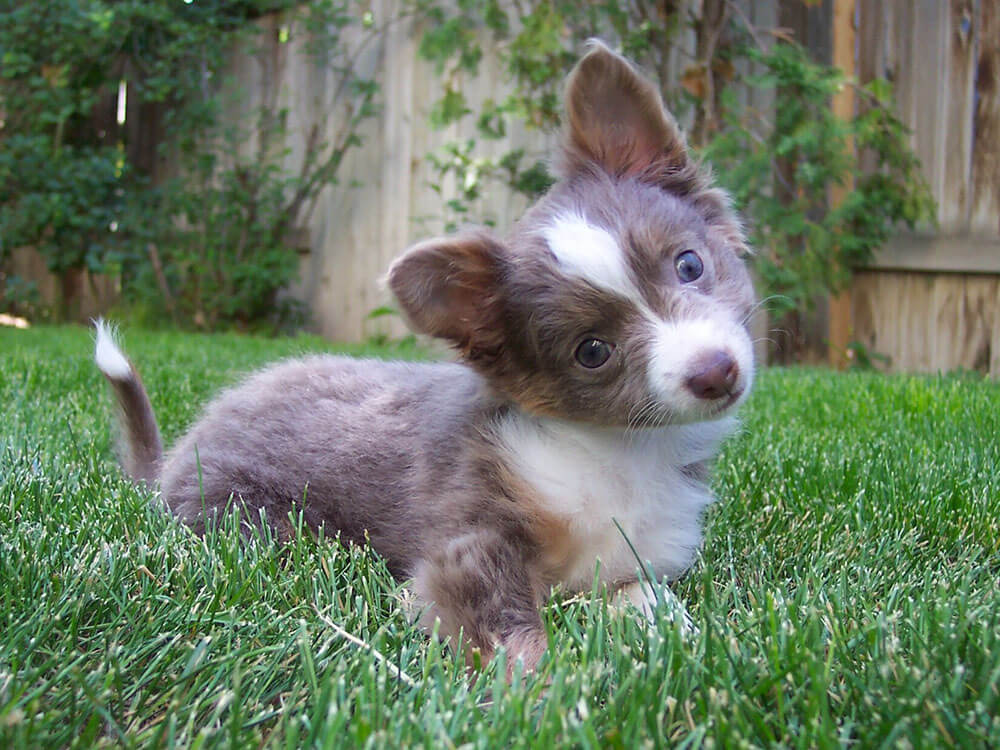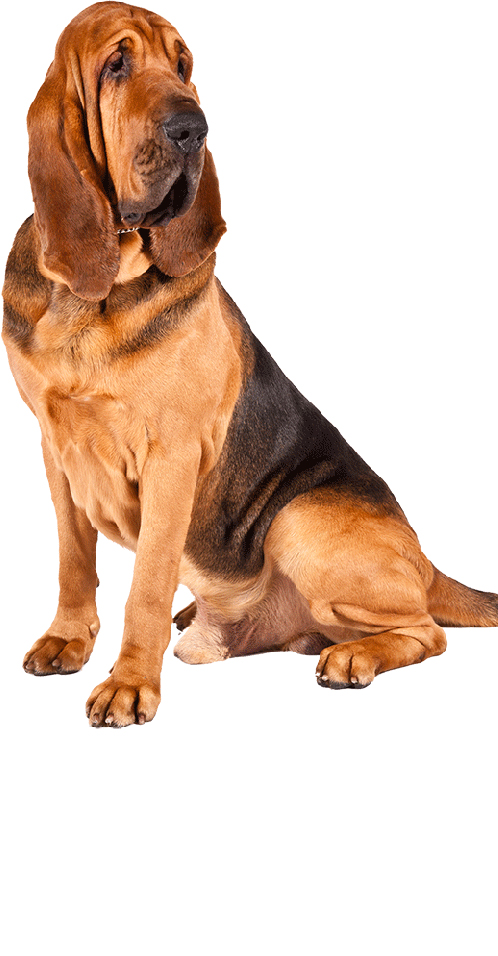Not the breed you're looking for?
Click Here
Featured Story

The Teacup Chihuahua, while distinct in its petite size, is not a separate breed from the standard Chihuahua that has been beloved by dog enthusiasts … [Read More...]
The bloodhound descended from St. Hubert hounds bred in France during the twelfth century. This large dog weighs 80–110 pounds and stands 58–69 centimetres at the withers. It is a tenacious scent hound, but it is a gentle, mild-mannered, and loving companion. It remains a popular breed for people with active lifestyles and is used by policemen in search and rescue.
Has the bloodhound caught your attention? Here is a brief background of this persistent scenthound.
The bloodhound is believed to have come from the hounds developed by Abbey St. Hubert monks in France in the twelfth century. In 1066, William the Conqueror brought these St. Hubert hounds to England and were given as gifts to monarchs and nobles.
As the popularity of the St. Hubert hounds dwindled in France because of the French Revolution, the breed became more famous in England because aside from being a great animal hunter, the breed was also used to track down criminals. The modern bloodhound that we see today comes from the specimens developed in England. It continues to be one of the most popular breeds and is used for tracking and K9 work. The breed is also a highly prized companion dog breed especially people with active lifestyles.
The bloodhound is a large scent hound with noble and honourable expression. This powerful dog weighs 80–110 pounds and stands 58–69 centimetres at the withers.
It is often described as sad-looking because of its loose skin that forms creases and folds. It has a large yet narrow head, which is proportionate to its length and slightly tapering to its muzzle. It also has a long neck and a strong jaw with a perfect scissor bite. Its nose is black with open nostrils, whilst its ears are long that almost reach the ground. Its medium eyes are either hazel or dark brown. It has a remarkably large bone structure, apparent in its muscular shoulders and hindquarters.
According to the Kennel Club standards, the breed comes in these colours: black and tan, liver and tan, and red. A little bit of white on the chest, feet, and tip of the tail is permissible.
Bloodhounds have long drooping ears because it is believed that the ears collect scent from the air and the surroundings. This allows the scent to be closer to the dog’s face and nose so that they can effectively follow a particular scent or smell.
The bloodhound is very easy to maintain grooming-wise because its weatherproof coat is short and glossy. Regular brushing is needed to keep it healthy. This breed is known to drool and has that strong, off-putting hound odour, but that does not necessarily mean it is dirty. To lessen the odour, use a shampoo with oatmeal and always wipe its mouth, skin, and folds.
The bloodhound’s pendulous ears tend to suffer from recurring ear infections, so make sure it is always clean and dry. Dental health is also important, so tooth brushing should be introduced whilst it is a puppy so it will get used to this routine process. To ensure that your pet’s physical health is in top shape, keep its nails trimmed and skin checked for fleas and red bumps or spots. These aspects should definitely not be ignored to lessen chances of infection or other diseases.
Yes, the bloodhound’s short and dense coat shed once or twice a year. Weekly brushing removes the dead hair and promotes the growth of new hair. Because they shed quite frequently during the shedding season, bloodhounds are not hypoallergenic dogs.
The bloodhound is tenacious when it comes to following a scent, but it is a gentle, mild-mannered, and affectionate hound. It is never aggressive towards people or other dogs. As a breed that thrives in the outdoors, it is not recommended for people who live in apartments. It is better off in a farm or ranch in the countryside where it can freely roam around. Whilst it may be tolerant of children, it is better for families with older children that can handle large and active dogs. It can live with other dogs especially those it grows up with.
The bloodhound is highly intelligent and trainable, but independent and stubborn by nature. This breed would choose to ignore a command especially when it goes after a scent it ‘needs’ to follow. It also has a tendency to test whether you mean what you say. This is the reason why it is not recommended for first-time dog owners as it needs an owner who is loving yet firm and consistent. It may be a large dog, but it is sensitive to harsh treatment. As it tends to pout and hide, positive reinforcements will make the training successful.
This breed is also known as a chewer, may it be food that smells so good or a new object that looks interesting. To remedy this, give it plenty of chew toys and introduce things that it can play with. Originally bred to trail deer and boar, today’s bloodhounds are used to assist the police in search and rescue. It is also a great family dog that requires a high level of care.
A typical serving for an adult bloodhound is four to eight cups of excellent-quality dry dog food per day. Because it is prone to bloat, divide its meal into two or three, and avoid heavy exercise before or after feeding. This breed is a messy eater, so try tucking its ear into a snood before meals. Its water bowl should have a narrow diameter.
Typical calorie needs of an adult bloodhound per day:
To ensure it gets the right balanced nutrients, the bloodhound should be fed high-quality dog food formulated for large and active dogs. The most important nutritional consideration for all dogs is protein to promote muscle and tissue growth. Glucosamine and chondroitin supplements are specifically important for the bones and joints of large dogs. Carbohydrates tend to have a bad name, but people need to understand that they provide dietary fibre, vitamins, and minerals. They should come from complex carbs like oats and sweet potato, not from wheat, corn, and soy.
Large dogs tend to have a shorter lifespan and the bloodhound is expected live to up to eight years. This breed is generally healthy but prone to certain health issues such as bloat, fold dermatitis, hip dysplasia and elbow dysplasia, epilepsy, entropion, ectropion, and hypothyroidism. Consult a veterinarian to check if your bloodhound displays peculiar behaviour, which may be a sign of illness.
In the exercise front, the bloodhound was bred as a determined scent hound, so it needs plenty of physical and mental activities. At least two hours of physical exercise spread throughout the day is needed to keep it happy. If it is unable to release its energy, it can become destructive, bark excessively, and even try to escape to look for something to do. A great exercise and bonding activity is giving it scent jobs. It will also happily accompany you in your runs and hunting expeditions.
Bloodhounds are not built for speed but they can run 20-30 mph to keep up with whatever it is tracking.
A Bloodhound puppy costs anywhere from £800 to £1000. Expect to pay more for a well-bred pedigree puppy from a KC-registered breeder. On top of this, you’ll have to spend around £200-£300 for essential dog supplies and equipment like leashes, collars, crates, beds, and toys.
High-quality dog food and treats cost £70 per month. Regular veterinary visits, preventive care, neutering/spaying, and flea treatments will cost you £1,500 for the first year alone. Getting pet insurance for your large hound is recommended in case of long-term treatments or major surgeries. Basic cover is around £70 whilst lifetime policy is £130 a month.

Are you sure the Bloodhound is the best breed for you? Take the Pet Breed Selector Quiz to find your perfect breed match.
Dog Breed Selector QuizDo you feel like a bloodhound is too much for you and your family to handle? Take our Pet Finder to help you find the best breed for you.